Evaluation of the Thermal Diffusivity of Carbon/Phenolic Composites (CPCs) through Oxy-Acetylene Torch (OAT) Test—Part 1: Experimental Characterization and Preliminary Validation
Abstract
1. Introduction
2. Materials and Methods
2.1. Matrices and Composites
2.2. Oxy-Acetylene Torch (OAT) Test
2.3. More Insights on the Heat Capacity of CPCs
2.4. Theoretical Background on the Adopted Heat Conduction Models
2.4.1. Ideal Semi-Infinite Solid
2.4.2. Heat Transfer Models in Presence of Non-Constant Thermo-Physical Properties
3. Results and Discussion
3.1. Post-OAT Appearance of the Tested CPCs
3.2. Evaluation of the Thermal Diffusivity: Constant Surface Temperature Scenario
3.3. Evaluation of the Thermal Diffusivity: Modified Constant Heat Flux Scenario
4. Concluding Considerations
5. Conclusions
Author Contributions
Funding
Institutional Review Board Statement
Data Availability Statement
Conflicts of Interest
Correction Statement
References
- Natali, M.; Kenny, J.M.; Torre, L. Science and Technology of Polymeric Ablative Materials for Thermal Protection Systems and Propulsion Devices: A Review. Prog. Mater. Sci. 2016, 84, 192–275. [Google Scholar] [CrossRef]
- Natali, M.; Torre, L.; Rallini, M. Interlaminar Properties, Ablation Resistance and Thermal Diffusivity of Carbon/Phenolic Composites (CPCs) Derived from Optimized High Char Yield Matrices: A Comparison with MX-4926 and FM-5014. Compos. Part. A Appl. Sci. Manuf. 2023, 175, 107801. [Google Scholar] [CrossRef]
- Natali, M.; Rallini, M.; Torre, L.; Puglia, D. High Temperature Composites from Renewable Resources: A Perspective on Current Technological Challenges for the Manufacturing of Non-Oil Based High Char Yield Matrices and Carbon Fibers. Front. Mater. 2022, 9, 805131. [Google Scholar] [CrossRef]
- Mouritz, A.; Gibson, A. Structural Properties of Composites in Fire. In Fire Properties of Polymer Composite Materials; Springer: Dordrecht, The Netherlands, 2006; pp. 163–213. [Google Scholar]
- Clayton, W.A.; Kennedy, P.B.; Evans, R.J.; Cotton, J.E.; Francisco, A.C.; Fabish, T.J.; Eldridge, E.A.; Lagedrost, J.F. Thermal properties of ablative chars. Report by the aerospace group of the boeing company under USAF, Contract Number AF 33(615)-3804. 1967. [Google Scholar]
- Mouritz, A.; Gibson, A. Modelling the Thermal Response of Composites in Fire. In Fire Properties of Polymer Composite Materials; Springer: Dordrecht, The Netherlands, 2006; pp. 133–161. [Google Scholar]
- Mouritz, A.P.; Feih, S.; Kandare, E.; Mathys, Z.; Gibson, A.G.; Des Jardin, P.E.; Case, S.W.; Lattimer, B.Y. Review of Fire Structural Modelling of Polymer Composites. Compos. Part A Appl. Sci. Manuf. 2009, 40, 1800–1814. [Google Scholar] [CrossRef]
- Yu, B.; Till, V.; Thomas, K. Modeling of Thermo-Physical Properties for FRP Composites under Elevated and High Temperature. Compos. Sci. Technol. 2007, 67, 3098–3109. [Google Scholar] [CrossRef]
- Lattimer, B.Y.; Ouellette, J.; Trelles, J. Thermal Response of Composite Materials to Elevated Temperatures. Fire Technol. 2011, 47, 823–850. [Google Scholar] [CrossRef]
- Henderson, J.B.; Wiebelt, J.A.; Tant, M.R. A Model for the Thermal Response of Polymer Composite Materials with Experimental Verification. J. Compos. Mater. 1985, 19, 579–595. [Google Scholar] [CrossRef]
- Henderson, J.B.; Wiecek, T.E. A Mathematical Model to Predict the Thermal Response of Decomposing, Expanding Polymer Composites. J. Compos. Mater. 1987, 21, 373–393. [Google Scholar] [CrossRef]
- Florio, J., Jr.; Henderson, J.B.; Test, F.L. Measurement of the Thermochemical Expansion of Porous Composite Materials. High Temp. High Press. 1989, 21, 157–165. [Google Scholar]
- Tant, M.R.; Henderson, J.B.; Boyer, C.T. Measurement and Modelling of the Thermochemical Expansion of Polymer Composites. Composites 1985, 16, 121–126. [Google Scholar] [CrossRef]
- Henderson, J.B.; Dohert, M.P. Measurement of Selected Properties of a Glass-Filled Polymer Composite. High. Temp. High. Press. 1987, 19, 95–102. [Google Scholar]
- Florio, J., Jr.; Henderson, J.B.; Test, F.L.; Hariharan, R. A Study of the Effects of the Assumption of Local-Thermal Equilibrium on the Overall Thermally-Induced Response of a Decomposing, Glass-Filled Polymer Composite. Int. J. Heat. Mass. Transf. 1991, 34, 135–147. [Google Scholar] [CrossRef]
- Sullivan, R.M. A Finite Element Model for Thermochemically Decomposing Polymers; The Pennsylvania State University: State College, PA, USA, 1990. [Google Scholar]
- Sullivan, R.M.; Salamon, N.J. A Finite Element Method for the Thermochemical Decomposition of Polymeric Materials—I. Theory. Int. J. Eng. Sci. 1992, 30, 431–441. [Google Scholar] [CrossRef]
- Sullivan, R.M.; Salamon, N.J. A Finite Element Method for the Thermochemical Decomposition of Polymeric Materials—II. Carbon Phenolic Composites. Int. J. Eng. Sci. 1992, 30, 939–951. [Google Scholar] [CrossRef]
- Sullivan, R.M. A Coupled Solution Method for Predicting the Thermostructural Response of Decomposing, Expanding Polymeric Composites. J. Compos. Mater. 1993, 27, 408–434. [Google Scholar] [CrossRef]
- Mcmanus, H.L.N.; Springer, G.S. High Temperature Thermomechanical Behavior of Carbon-Phenolic and Carbon-Carbon Composites, I. Analysis. J. Compos. Mater. 1992, 26, 206–229. [Google Scholar] [CrossRef]
- Mcmanus, H.L.N.; Springer, G.S. High Temperature Thermomechanical Behavior of Carbon-Phenolic and Carbon-Carbon Composites, II. Results. J. Compos. Mater. 1992, 26, 230–255. [Google Scholar] [CrossRef]
- Dimitrienko, Y.I. Thermal Stresses and Heat-Mass Transfer in Ablating Composite Materials. Int. J. Heat. Mass. Transf. 1995, 38, 139–146. [Google Scholar] [CrossRef]
- Dimitrienko, Y.I. Thermomechanical Behaviour of Composite Materials and Structures under High Temperatures: 1. Materials. Compos. Part A Appl. Sci. Manuf. 1997, 28, 453–461. [Google Scholar] [CrossRef]
- Dimitrienko, Y.I. Thermomechanical Behaviour of Composite Materials and Structures under High Temperatures: 2. Structures. Compos. Part A Appl. Sci. Manuf. 1997, 28, 463–471. [Google Scholar] [CrossRef]
- Gibson, A.G.; Wu, Y.-S.; Chandler, H.W.; Wilcox, J.A.D.; Bettess, P. Model for the Thermal Performance of Thick Composite Laminates in Hydrocarbon Fires. Rev. Institute Fr. Pet. 1995, 50, 69–74. [Google Scholar] [CrossRef]
- Dodds, N.; Gibson, A.G.; Dewhurst, D.; Davies, J.M. Fire Behaviour of Composite Laminates. Compos. Part A Appl. Sci. Manuf. 2000, 31, 689–702. [Google Scholar] [CrossRef]
- Zheng, F.; Ren, Z.; Xu, B.; Wan, K.; Cai, J.; Yang, J.; Zhang, T.; Wang, P.; Niu, B.; Zhang, Y.; et al. Elucidating Multiple-Scale Reaction Behaviors of Phenolic Resin Pyrolysis via TG-FTIR and ReaxFF Molecular Dynamics Simulations. J. Anal. Appl. Pyrolysis 2021, 157, 105222. [Google Scholar] [CrossRef]
- Jiang, H.; Wang, J.; Wu, S.; Wang, B.; Wang, Z. Pyrolysis Kinetics of Phenol–Formaldehyde Resin by Non-Isothermal Thermogravimetry. Carbon. N.Y. 2010, 48, 352–358. [Google Scholar] [CrossRef]
- Torre, L.; Kenny, J.M.; Maffezzoli, A.M. Degradation Behaviour of a Composite Material for Thermal Protection Systems Part I—Experimental Characterization. J. Mater. Sci. 1998, 33, 3137–3143. [Google Scholar] [CrossRef]
- Torre, L.; Kenny, J.M.; Maffezzoli, A.M. Degradation Behaviour of a Composite Material for Thermal Protection Systems. Part II—Process Simulation. J. Mater. Sci. 1998, 33, 3145–3149. [Google Scholar] [CrossRef]
- Natali, M.; Torre, L.; Puri, I.; Rallini, M. Thermal Degradation of Phenolics and Their Carbon Fiber Derived Composites: A Feasible Protocol to Assess the Heat Capacity as a Function of Temperature through the Use of Common DSC and TGA Analysis. Polym. Degrad. Stab. 2022, 195, 109793. [Google Scholar] [CrossRef]
- Sykes, G.F. Decomposition Characteristics of a Char-Forming Phenolic Polymer Used for Ablative Composites; National Aeronautics and Space Administration: Washington, DC, USA, 1967.
- Shilav, R.; Leitner, A.; Gany, A. Development of Thermal Conductivity Apparatus for Ablative Composite Materials. In Proceedings of the 57th Israel Annual Conference on Aerospace Sciences, Tel-Aviv & Haifa, Israel, 15–16 March 2017. [Google Scholar]
- ASTM C1113/C1113M; Standard Test Method for Thermal Conductivity of Refractories by Hot Wire (Platinum Resistance Thermometer Technique). iTeh Standards: Toronto, Italy, 2013.
- Roder, H.M.; Perkins, R.A.; Laesecke, A.; Nieto de Castro, C.A. Absolute Steady-State Thermal Conductivity Measurements by Use of a Transient Hot Wire System. J. Res. Natl. Inst. Stand. Technol. 2000, 105, 221–253. [Google Scholar] [CrossRef] [PubMed]
- Shilav, R.; Leitner, A.; Gany, A. New Measurement Technique for Thermal Conductivity of Ablative Materials. Int. J. Energetic Mater. Chem. Propuls. 2018, 17, 171–182. [Google Scholar] [CrossRef]
- Dimitrienko, Y.I. Thermomechanics of Composites under High Temperatures; Springer: Dordrecht, The Netherlands, 1999; Volume 65, ISBN 978-90-481-5122-6. [Google Scholar]
- Bahramian, A.R.; Kokabi, M. Ablation Mechanism of Polymer Layered Silicate Nanocomposite Heat Shield. J. Hazard. Mater. 2009, 166, 445–454. [Google Scholar] [CrossRef] [PubMed]
- Paul, A.; Binner, J.G.P.; Vaidhyanathan, B.; Heaton, A.C.J.; Brown, P.M. Heat Flux Mapping of Oxyacetylene Flames and Their Use to Characterise Cf-HfB2 Composites. Adv. Appl. Ceram. 2016, 115, 158–165. [Google Scholar] [CrossRef]
- Zibitsker, A.; Berreby, M.; Michaels, D.; Shilav, R.; Frisman, I. Ultrasonic Temperature Compensating Method for Tracking Decomposition Front in Silica-Phenolic Thermal Protection Material. J. Thermophys. Heat. Trans. 2021, 35, 770–787. [Google Scholar] [CrossRef]
- Minges, M.L. Thermophysical Characteristics of High-Performance Ablative Composites. In Ablative Plastics; D’Aelio, G.F., Parker, J.A., Eds.; Marcel Dekker Inc.: New York, NY, USA, 1971; pp. 287–312. [Google Scholar]
- Myrick, J.A.; Keyhani, M.; Frankel, J.I. Determination of Surface Heat Flux and Temperature Using in-Depth Temperature Data—Experimental Verification. Int. J. Heat. Mass. Transf. 2017, 111, 982–998. [Google Scholar] [CrossRef]
- Gazarik, M.J.; Wright, M.J.; Little, A.; Cheatwood, F.M.; Herath, J.A.; Munk, M.M.; Novak, F.J.; Martinez, E.R. Overview of the MEDLI Project. In Proceedings of the 2008 IEEE Aerospace Conference, Big Sky, MT, USA, 1–8 March 2008; IEEE: Piscataway, NJ, USA, 2008; pp. 1–12. [Google Scholar]
- Bose, D.; Santos, J.A.; Rodriguez, E.; White, T.R.; Mahzari, M. Mars Science Laboratory Heat Shield Instrumentation and Arc Jet Characterization. In Proceedings of the 44th AIAA Thermophysics Conference, San Diego, CA, USA, 24–27 June 2013; American Institute of Aeronautics and Astronautics: Reston, VA, USA, 2013. [Google Scholar]
- Morzhukhina, A.V.; Alifanov, O.M.; Budnik, S.A.; Nenarokomov, A.V.; Titov, D.M.; Delfini, A.; Pastore, R.; Santoni, F.; Albano, M.; Marchetti, M. Estimation of the Thermophysical Properties of C/C Plates with Ceramic Nanocoating at Different SiO2 Filling for Aerospace Applications. Aerotec. Missili Spaz. 2023, 103, 3–15. [Google Scholar] [CrossRef]
- Alifanov, O.M.; Budnik, S.A.; Nenarokomov, A.V.; Netelev, A.V.; Okhapkin, A.S. Thermophysical Characteristics of Fibrous Thermoprotective Materials at High Temperatures. J. Eng. Phys. Thermophys. 2021, 94, 1052–1062. [Google Scholar] [CrossRef]
- Alifanov, O.M.; Budnik, S.A.; Mikhaylov, V.V.; Nenarokomov, A.V.; Titov, D.M.; Yudin, V.M. An Experimental–Computational System for Materials Thermal Properties Determination and Its Application for Spacecraft Structures Testing. Acta Astronaut. 2007, 61, 341–351. [Google Scholar] [CrossRef]
- Zhou, J.; Zhang, Y.; Chen, J.K.; Feng, Z.C. Inverse Heat Conduction in a Composite Slab with Pyrolysis Effect and Temperature-Dependent Thermophysical Properties. J. Heat Transf. 2010, 13, 034502. [Google Scholar] [CrossRef]
- The European Space Agency. N° 46–2023: Vega-C Zefiro40 Test: Independent Enquiry Commission Announces Conclusions. 2023. Available online: https://www.esa.int/Newsroom/Press_Releases/Vega-C_Zefiro40_Test_Independent_Enquiry_Commission_announces_conclusions (accessed on 19 January 2024).
- NASA. NASA Shares Progress Toward Early Artemis Moon Missions with Crew. 2024. Available online: https://www.nasa.gov/news-release/nasa-shares-progress-toward-early-artemis-moon-missions-with-crew (accessed on 19 January 2024).
- Natali, M.; Monti, M.; Kenny, J.; Torre, L. Synthesis and Thermal Characterization of Phenolic Resin/Silica Nanocomposites Prepared with High Shear Rate-Mixing Technique. J. Appl. Polym. Sci. 2011, 120, 2632–2640. [Google Scholar] [CrossRef]
- Natali, M.; Monti, M.; Kenny, J.M.; Torre, L. A Nanostructured Ablative Bulk Molding Compound: Development and Characterization. Compos. Part. A Appl. Sci. Manuf. 2011, 42, 1197–1204. [Google Scholar] [CrossRef]
- Natali, M.; Koo, J.H.; Allcorn, E.; Ezekoye, O.A. An In-Situ Ablation Recession Sensor for Carbon/Carbon Ablatives Based on Commercial Ultra-Miniature Thermocouples. Sens. Actuators B Chem. 2014, 196, 46–56. [Google Scholar] [CrossRef]
- Vojvodich, N.S. Hypervelocity Heat Protection—A Review of Laboratory Experiments. In Ablative Plastics; Marcel Dekker: New York, NY, USA, 1971; pp. 41–68. ISBN 13: 9780824711207. [Google Scholar]
- Koubek, F.J. A Review of Ablative Studies of Interest to Naval Applications. In Ablative Plastics; Marcel Dekker: New York, NY, USA, 1971; pp. 69–83. [Google Scholar]
- Natali, M.; Puri, I.; Kenny, J.M.; Torre, L.; Rallini, M. Microstructure and Ablation Behavior of an Affordable and Reliable Nanostructured Phenolic Impregnated Carbon Ablator (PICA). Polym. Degrad. Stab. 2017, 141, 84–96. [Google Scholar] [CrossRef]
- Natali, M.; Rallini, M.; Puglia, D.; Kenny, J.; Torre, L. EPDM Based Heat Shielding Materials for Solid Rocket Motors: A Comparative Study of Different Fibrous Reinforcements. Polym. Degrad. Stab. 2013, 98, 2131–2139. [Google Scholar] [CrossRef]
- Toulouklan, Y.S.; Saxens, S.C.; Klemena, P.G. Thermophysical Properties of Matter—The TPRC Data 1976, 6s.
- Natali, M.; Puri, I.; Rallini, M.; Kenny, J.; Torre, L. Ablation Modeling of State of the Art EPDM Based Elastomeric Heat Shielding Materials for Solid Rocket Motors. Comput. Mater. Sci. 2016, 111, 460–480. [Google Scholar] [CrossRef]
- Shieds, S. Scout Nozzle Data Book (No. NASA-CR-145136), 1976; NASA: Washington, DC, USA, 1976.
- Schaefer, J.W.; Dahm, T.J. Studies of Nozzle Ablative Material Performance for Large Solid Boosters. NASA CR-72080 Aerotherm Report No. 66-2; NASA: Washington, DC, USA, 1966.
- Clayton, W.A.; Kennedy, P.B.; Evans, R.J.; Cotton, J.E.; Francisco, A.C.; Fabish, T.J.; Eldridge, E.A.; Lagedrost, J.F. AFML-TR-67-413; Battelle Memorial Institute: Columbus, OH, USA, 1968.
- Pears, C.D.; Engelke, W.T.; Thornburgh, J.D. The Thermal and Mechanical Properties of Five Ablative Reinforced Plastics from Room Temperature to 750°F. U.S. Air Force Report; AFML-TR-65-133; Southern Research Institute: Birmingham, AL, USA, 1965. [Google Scholar]
- Incropera, F.P.; Dewitt, D.P.; Bergman, T.L.; Lavine, A.S. Transient Conduction. In Fundamentals of Heat and Mass Transfer; John Wiley & Sons: Hoboken, NJ, USA, 2007; pp. 255–319. [Google Scholar]
- Liston, E.M. Arc-Image Testing of Ablation Materials. In Ablative Plastics; D’Aelio, G.F., Parker, J.A., Eds.; Marcel Dekker Inc.: New York, NY, USA, 1971; pp. 379–407. [Google Scholar]
- Mathis, J.R.; Laramee, R.C. Development of Low Cost Ablative Nozzles for Solid Propellant Rocket Motors; Thiokol Chemical Corporation: Brigham City, UT, USA, 1970; Volume II. [Google Scholar]
- Wang, W.-X.; Dgany, O.; Wolf, S.G.; Levy, I.; Algom, R.; Pouny, Y.; Wolf, A.; Marton, I.; Altman, A.; Shoseyov, O. Aspen SP1, an Exceptional Thermal, Protease and Detergent-Resistant Self-Assembled Nano-Particle. Biotechnol. Bioeng. 2006, 95, 161–168. [Google Scholar] [CrossRef]
- Lachaud, J.; Cozmuta, I.; Mansour, N.N. Multiscale Approach to Ablation Modeling of Phenolic Impregnated Carbon Ablators. J. Spacecr. Rockets 2010, 47, 910–921. [Google Scholar] [CrossRef]
- Lyon, R.E. Heat Release Kinetics. Fire Mater. 2000, 24, 179–186. [Google Scholar] [CrossRef]
- D’alelio, G.F. Structural Design and Thermal Properties of Polymers. J. Macromol. Sci. Part A Chem. 1969, 3, 411–452. [Google Scholar] [CrossRef]
- Fyfe, C.A.; McKinnon, M.S.; Rudin, A.; Tchir, W.J. Investigation of the Mechanism of the Thermal Decomposition of Cured Phenolic Resins by High-Resolution 13C CP/MAS Solid-State NMR Spectroscopy. Macromolecules 1983, 16, 1216–1219. [Google Scholar] [CrossRef]
- Rastogi, R.P.; Deepak, D. Char Formation in Ablatives. AIAA J. 1974, 12, 114–116. [Google Scholar] [CrossRef]
- Morterra, C.; Low, M.J.D.I.R. Studies of Carbons—VII. The Pyrolysis of a Phenol-Formaldehyde Resin. Carbon. N. Y. 1985, 23, 525–530. [Google Scholar] [CrossRef]
- Lum, R.; Wilkins, C.W.; Robbins, M.; Lyons, A.M.; Jones, R.P. Thermal Analysis of Graphite and Carbon-Phenolic Composites by Pyrolysis-Mass Spectrometry. Carbon. N. Y. 1983, 21, 111–116. [Google Scholar] [CrossRef]
- Blazso, M.; Tóth, T. Sequence of Phenolic Units in Phenol—Formaldehyde Polycondensates Studied by Pyrolysis—Gas Chromatography/Mass Spectrometry. J. Anal. Appl. Pyrolysis 1991, 19, 251–263. [Google Scholar] [CrossRef]
- Schmidt, D. Hypersonic Atmospheric Flight. In Environmental Effects on Polymeric Materials, Environments; Rosato, D.V., Schwartz, R.T., Eds.; Interscience Publishers: Geneva, Swizterland, 1968; pp. 488–578. [Google Scholar]
- Schmidt, D. Ablative Polymers in Aerospace Technology. In Ablative Plastics; D’Aelio, G.F., Parker, J.A., Eds.; Marcel Dekker Inc.: New York, NY, USA, 1971; pp. 1–35. [Google Scholar]
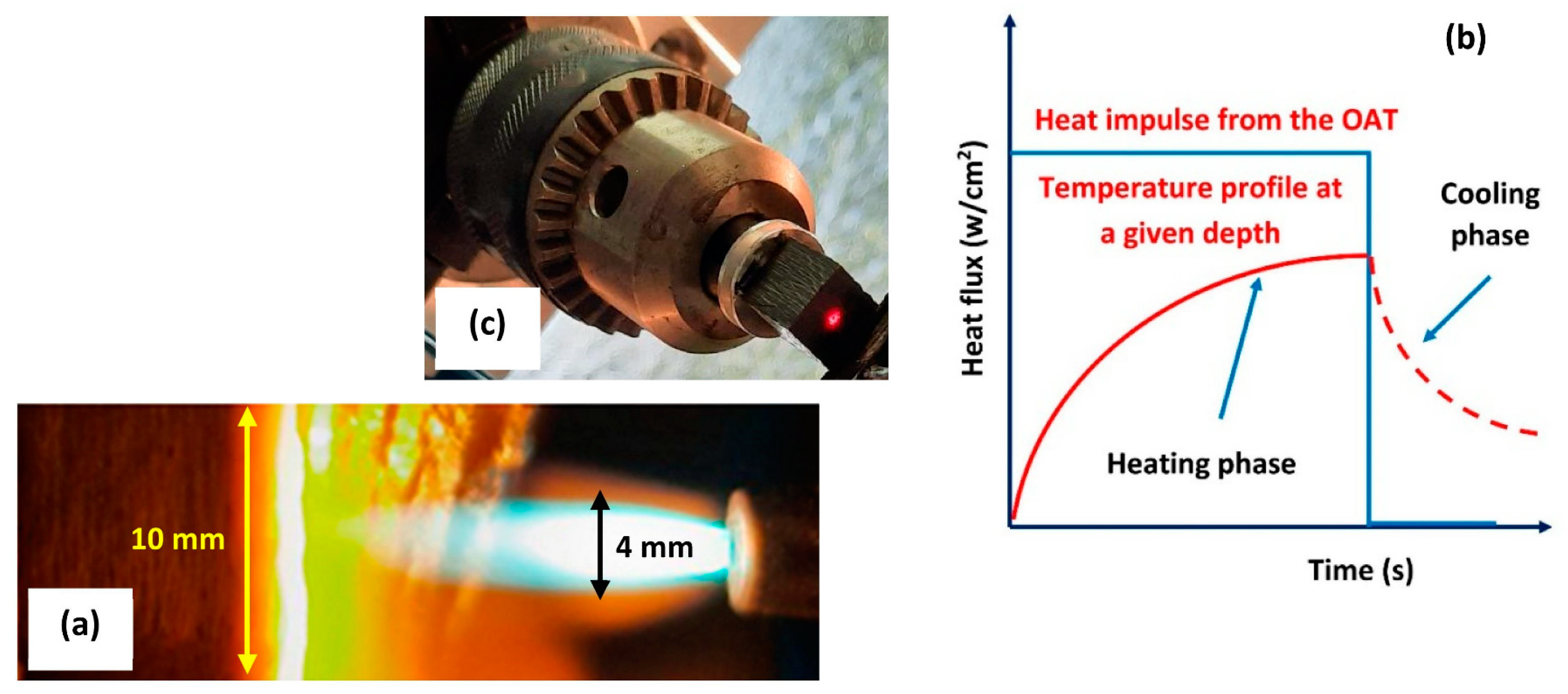
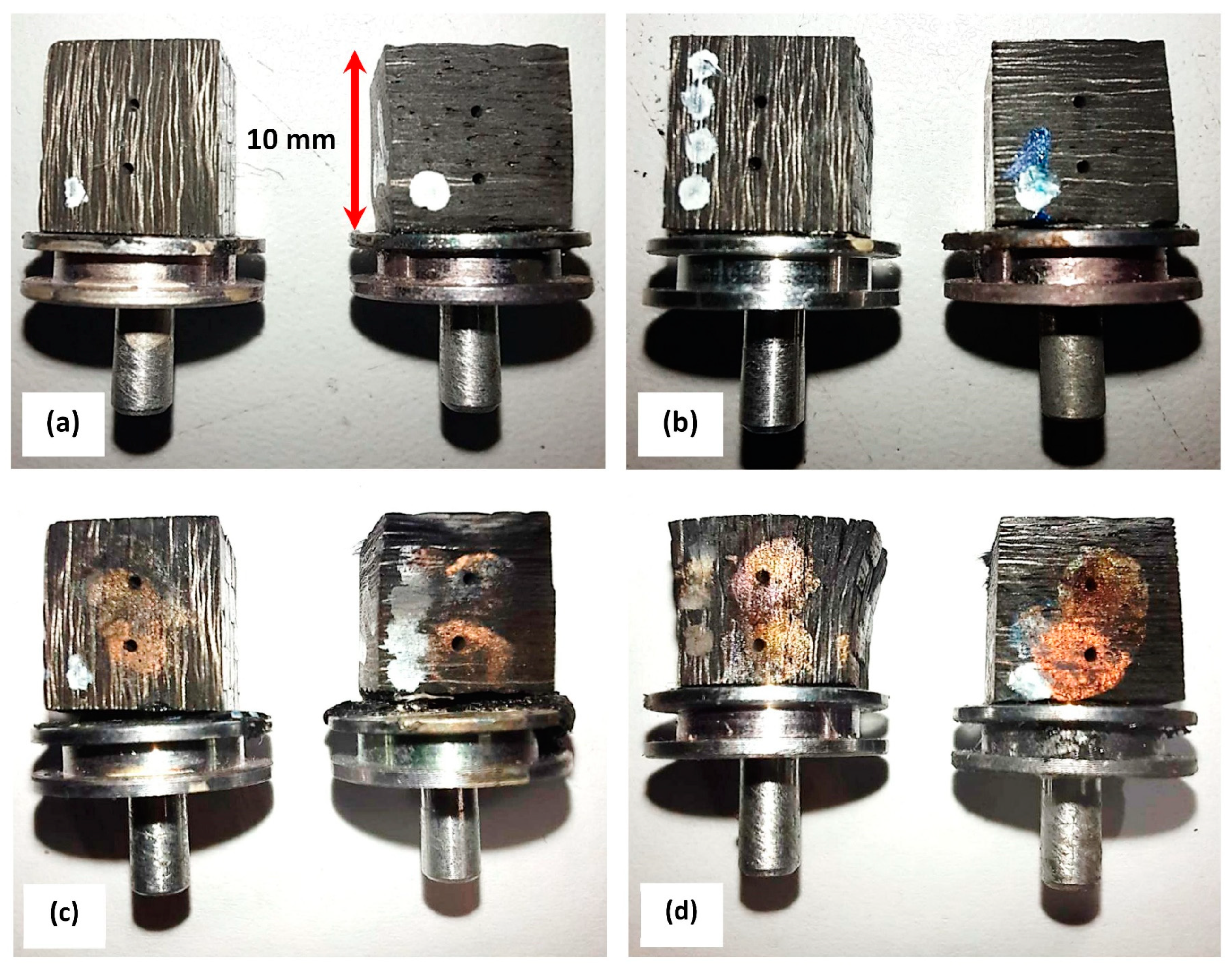

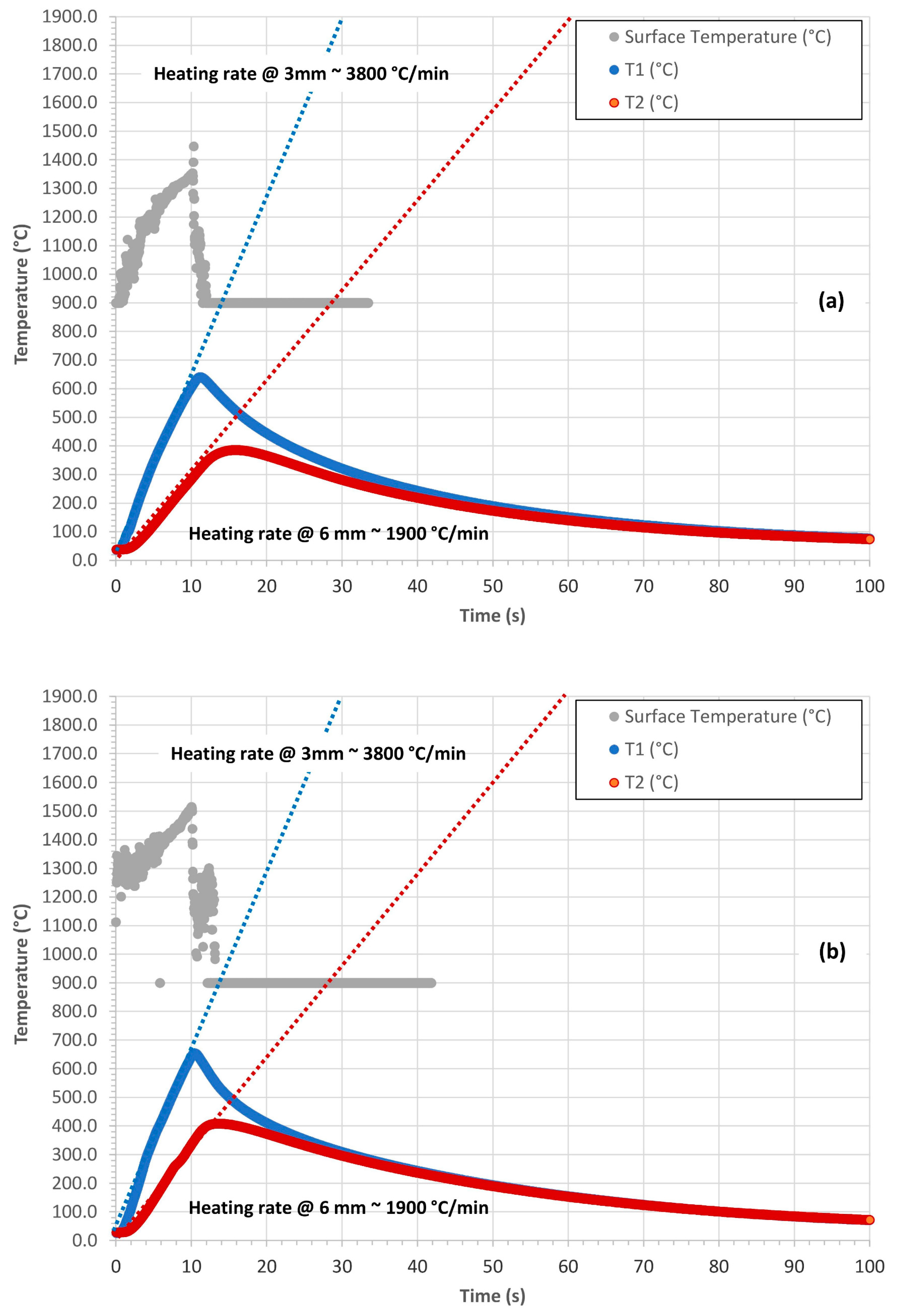

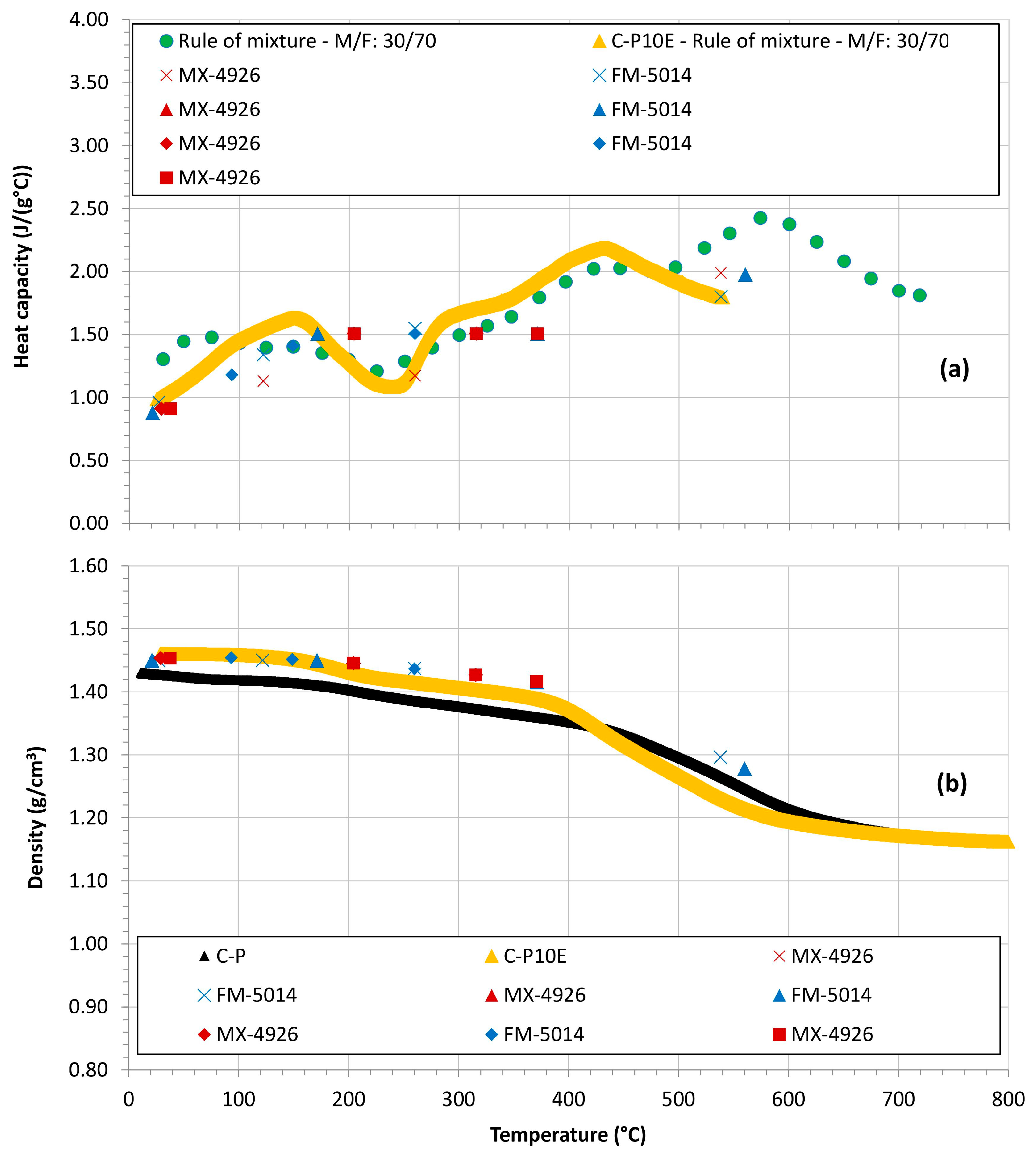

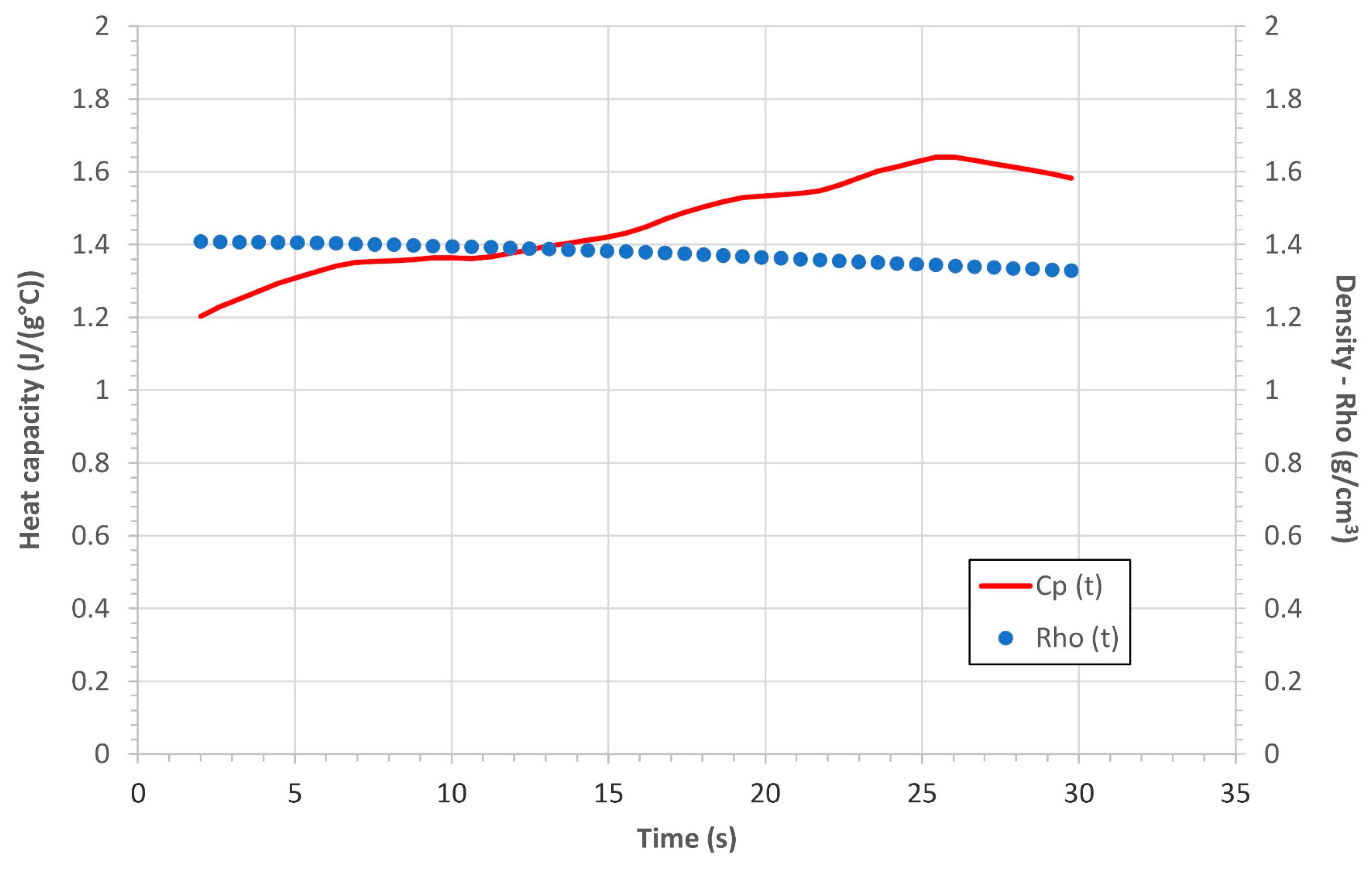

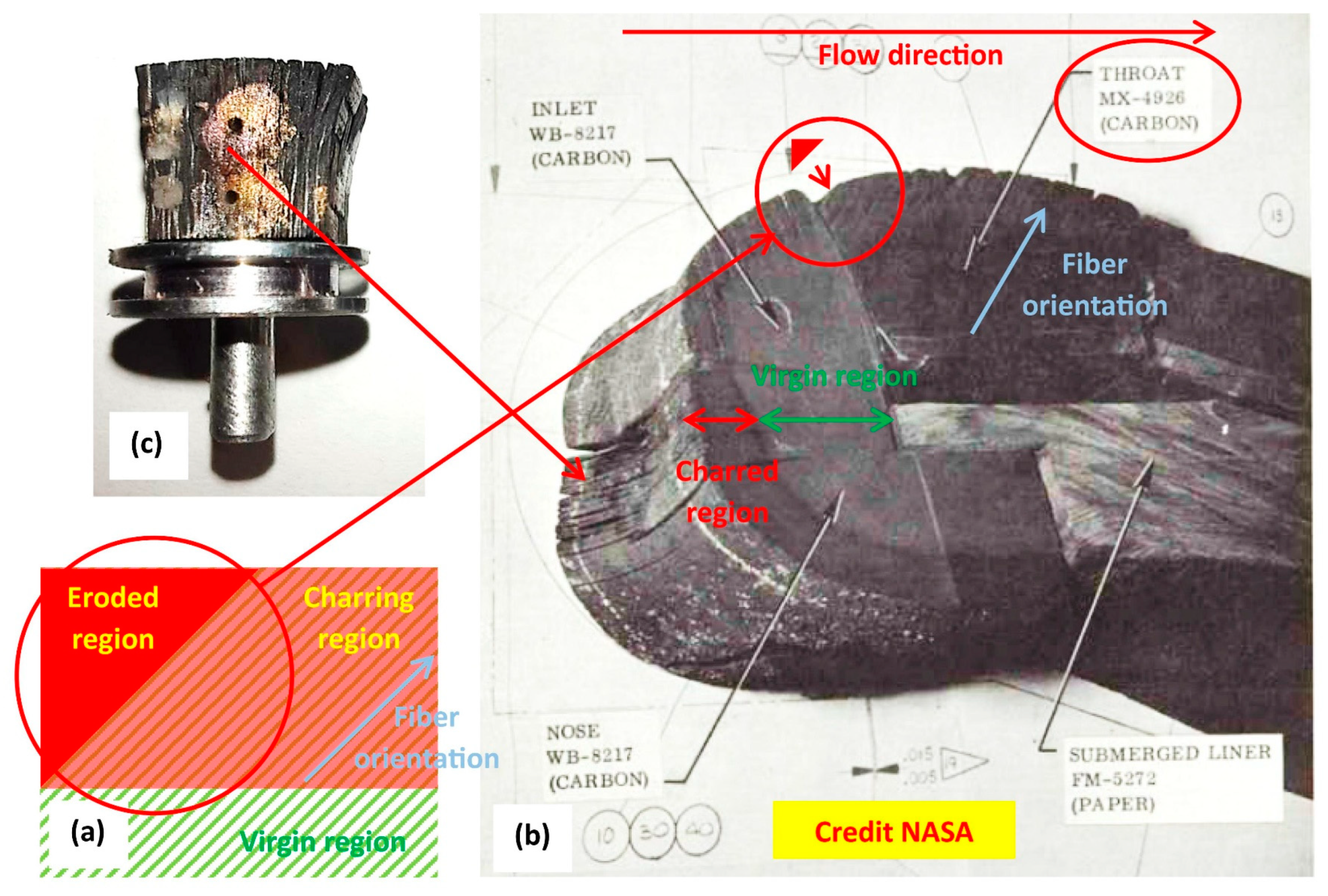
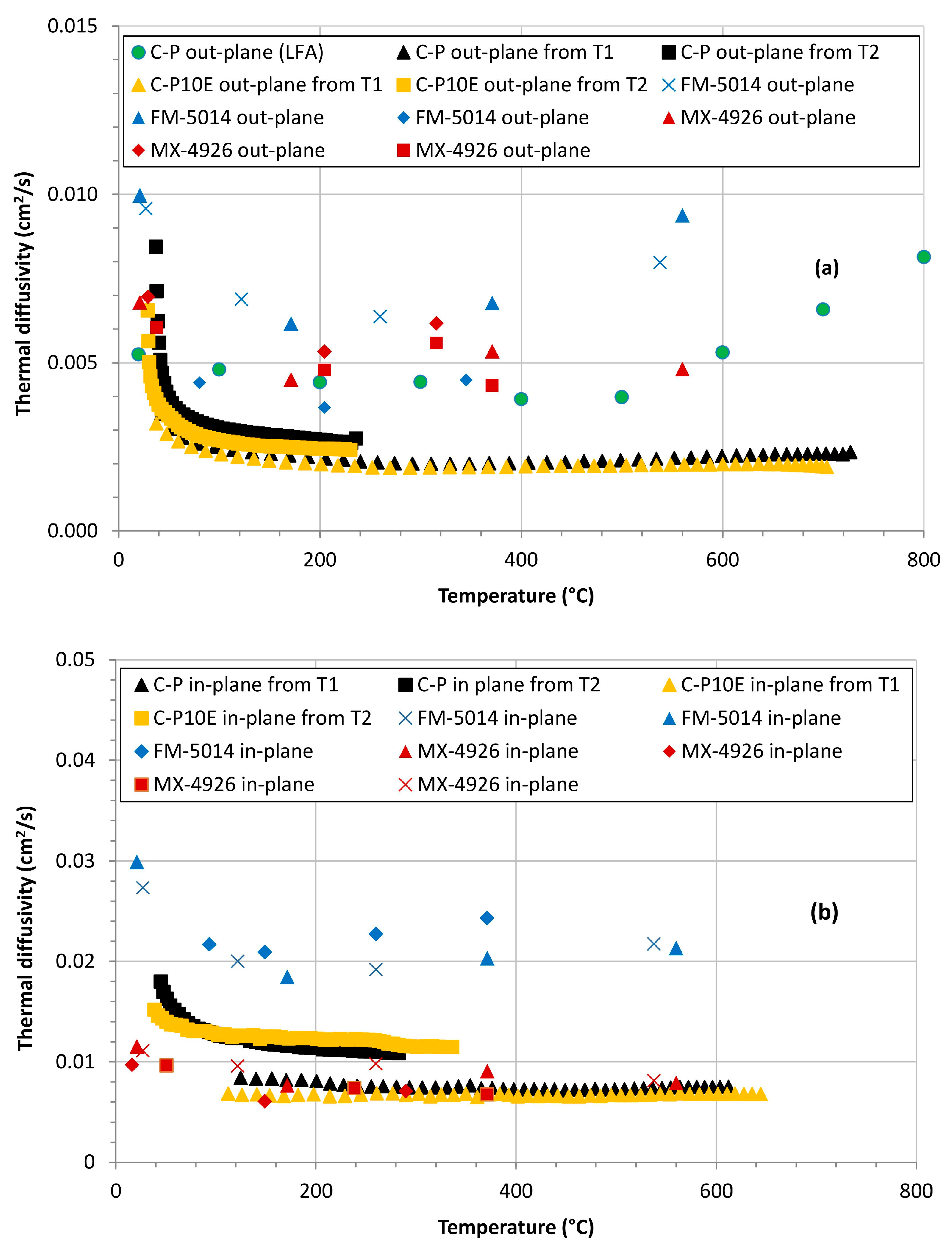
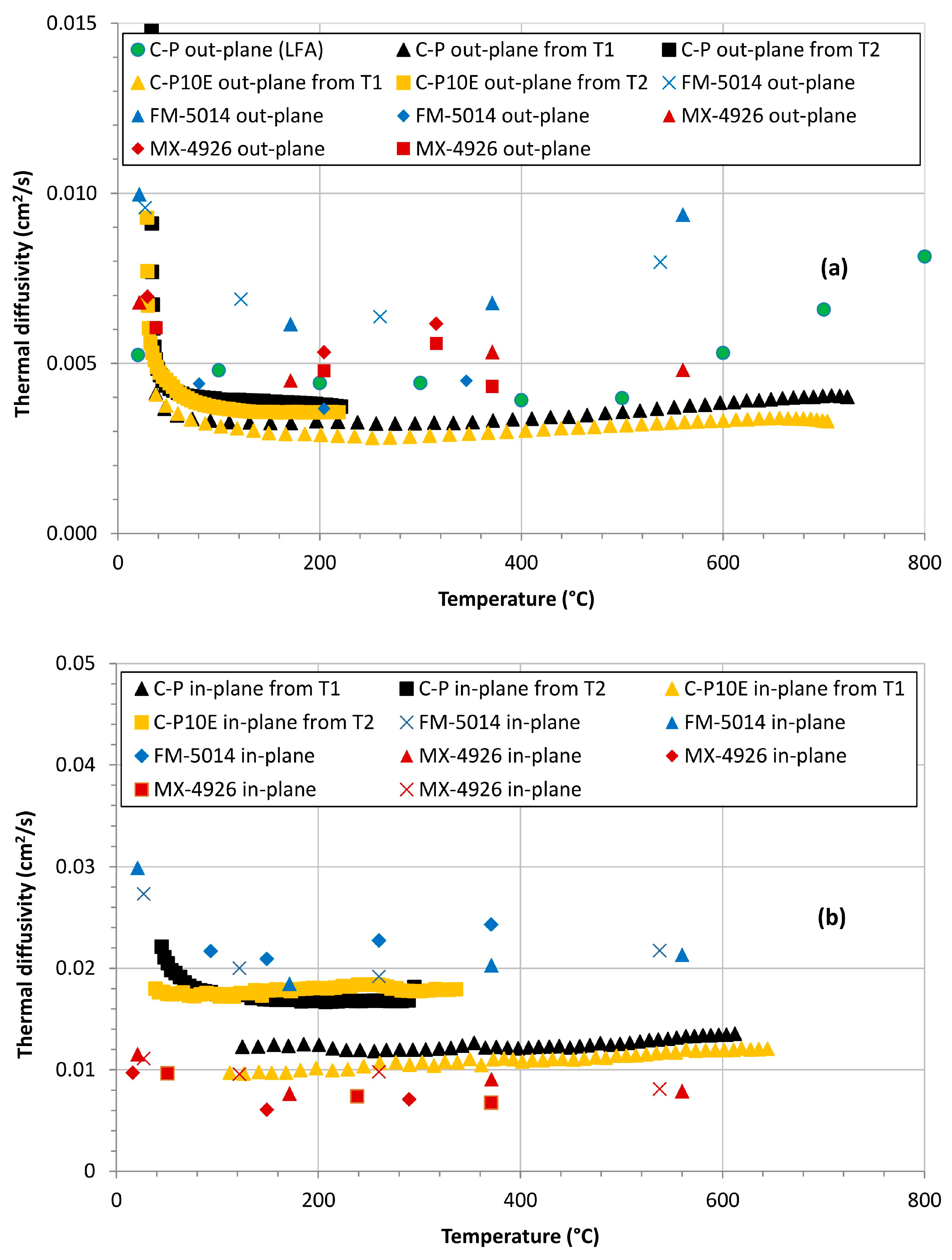


| Method | Temperature Range (K) | Thermal Conductivity Range (W/mK) | Material | Reference |
|---|---|---|---|---|
| Guarded Hot Plate | 80–800 | 0.001–0.5 | Polymers | ASTM C177 Flynn et al. (2002) [35] |
| Heat Flow Meter | 80–800 | 5–400 | Solids | ASTM C518 [36] |
| Radial Heat Flow | 4–1000 | >0.1 | Solids, Powders | Maglic et al. (1992) [37] |
| Panel Test | 300–1250 | 0.05–15 | Solids | Daryabeigi (1999) [38] |
| Laser Flash | 80–2800 | (*) | Solids | ASTM E1461 [39] |
| Hot Wire | 300–1800 | <15 | Solids, Liquids | ASTM C1113 Roder et al. (2000) [40] |
Disclaimer/Publisher’s Note: The statements, opinions and data contained in all publications are solely those of the individual author(s) and contributor(s) and not of MDPI and/or the editor(s). MDPI and/or the editor(s) disclaim responsibility for any injury to people or property resulting from any ideas, methods, instructions or products referred to in the content. |
© 2024 by the authors. Licensee MDPI, Basel, Switzerland. This article is an open access article distributed under the terms and conditions of the Creative Commons Attribution (CC BY) license (https://creativecommons.org/licenses/by/4.0/).
Share and Cite
Natali, M.; Torre, L.; Rallini, M. Evaluation of the Thermal Diffusivity of Carbon/Phenolic Composites (CPCs) through Oxy-Acetylene Torch (OAT) Test—Part 1: Experimental Characterization and Preliminary Validation. Polymers 2024, 16, 577. https://doi.org/10.3390/polym16050577
Natali M, Torre L, Rallini M. Evaluation of the Thermal Diffusivity of Carbon/Phenolic Composites (CPCs) through Oxy-Acetylene Torch (OAT) Test—Part 1: Experimental Characterization and Preliminary Validation. Polymers. 2024; 16(5):577. https://doi.org/10.3390/polym16050577
Chicago/Turabian StyleNatali, Maurizio, Luigi Torre, and Marco Rallini. 2024. "Evaluation of the Thermal Diffusivity of Carbon/Phenolic Composites (CPCs) through Oxy-Acetylene Torch (OAT) Test—Part 1: Experimental Characterization and Preliminary Validation" Polymers 16, no. 5: 577. https://doi.org/10.3390/polym16050577
APA StyleNatali, M., Torre, L., & Rallini, M. (2024). Evaluation of the Thermal Diffusivity of Carbon/Phenolic Composites (CPCs) through Oxy-Acetylene Torch (OAT) Test—Part 1: Experimental Characterization and Preliminary Validation. Polymers, 16(5), 577. https://doi.org/10.3390/polym16050577






